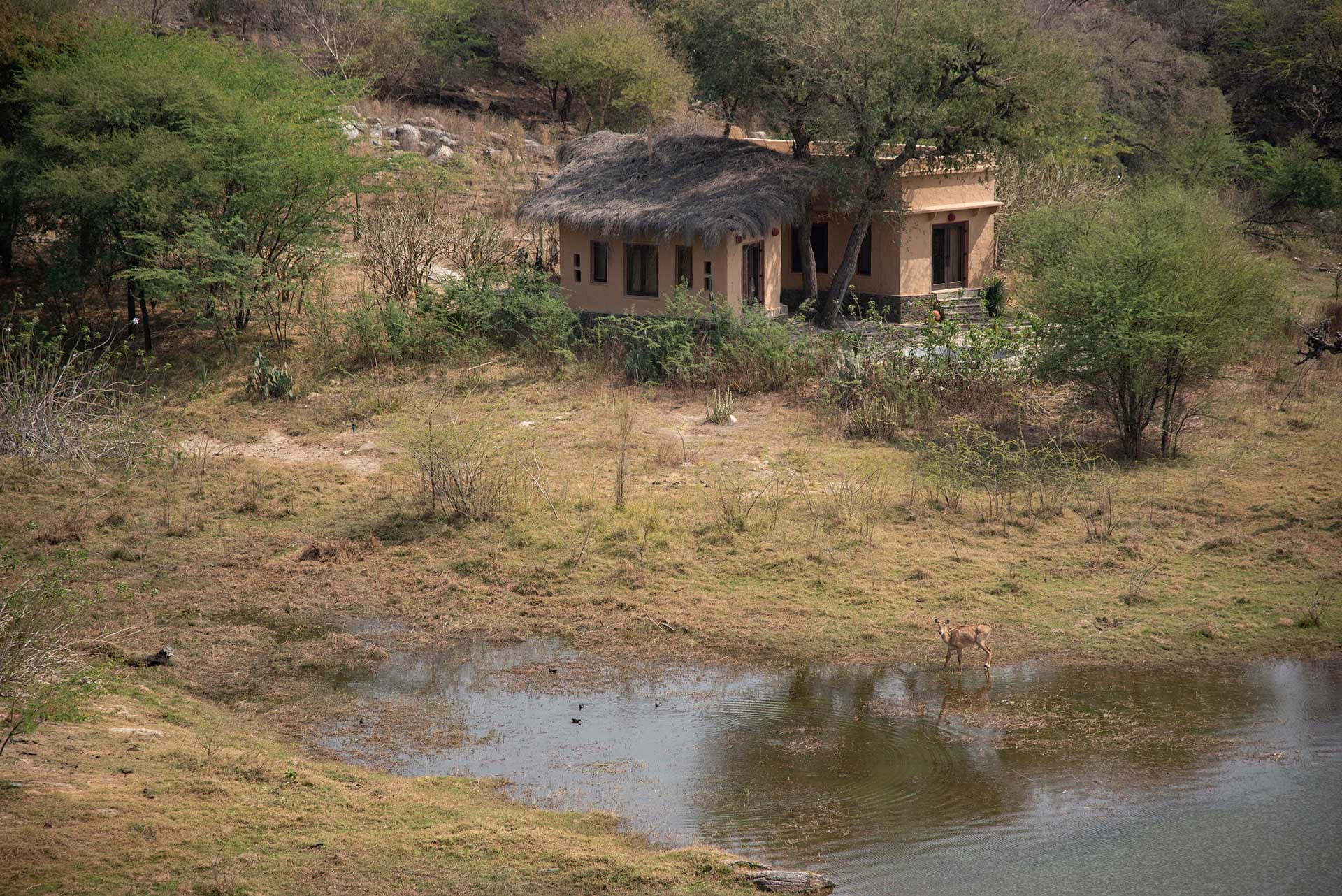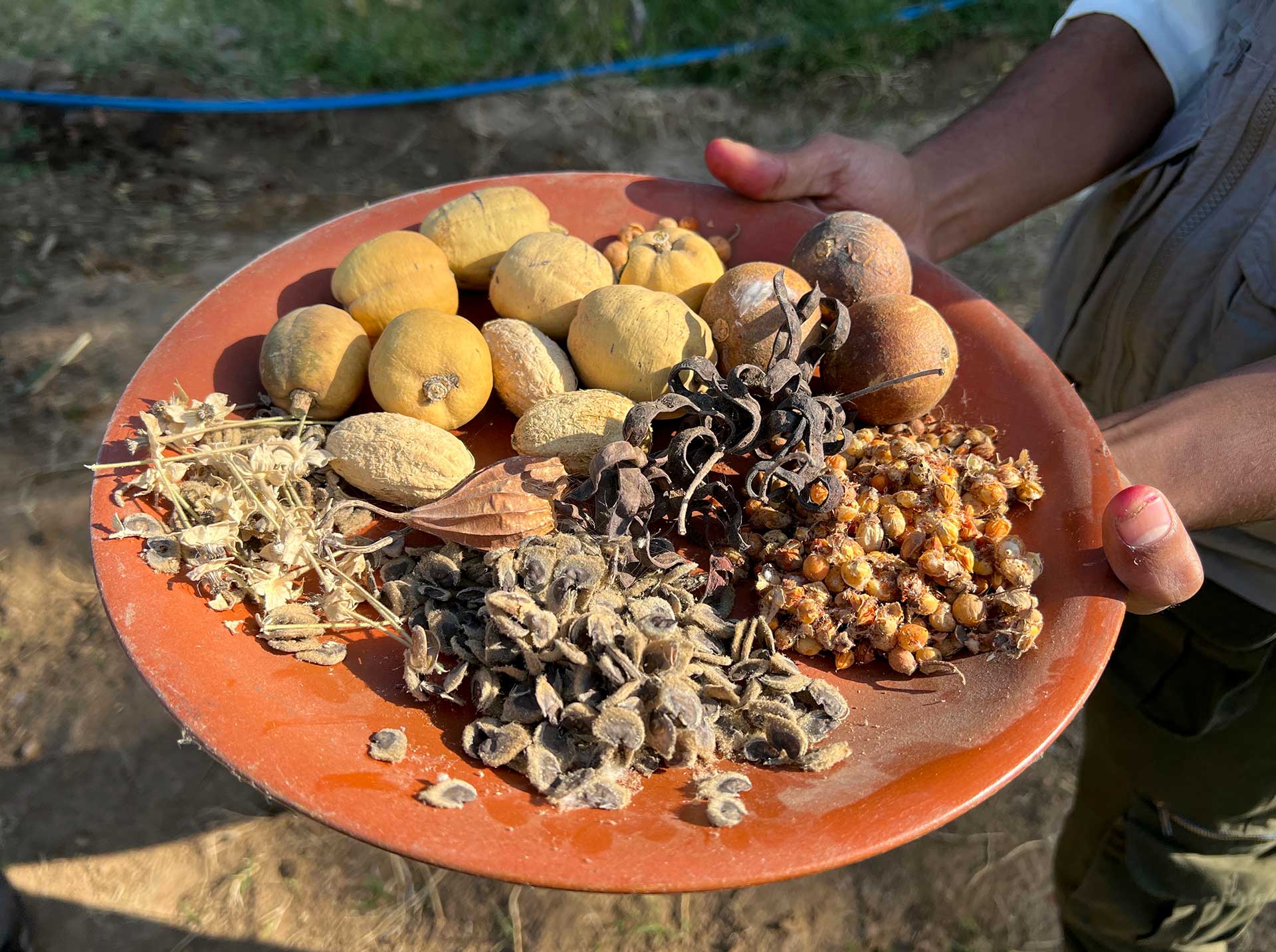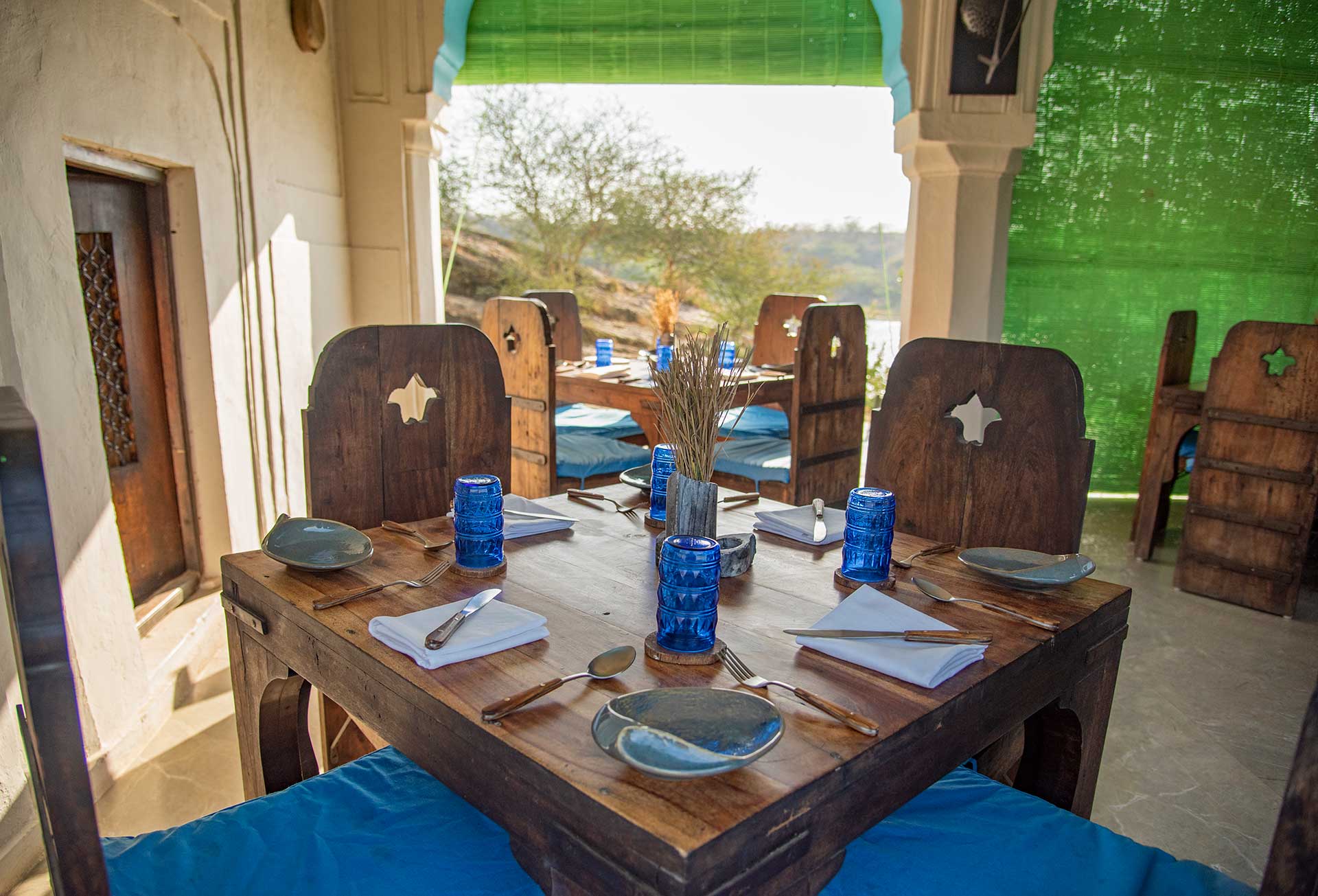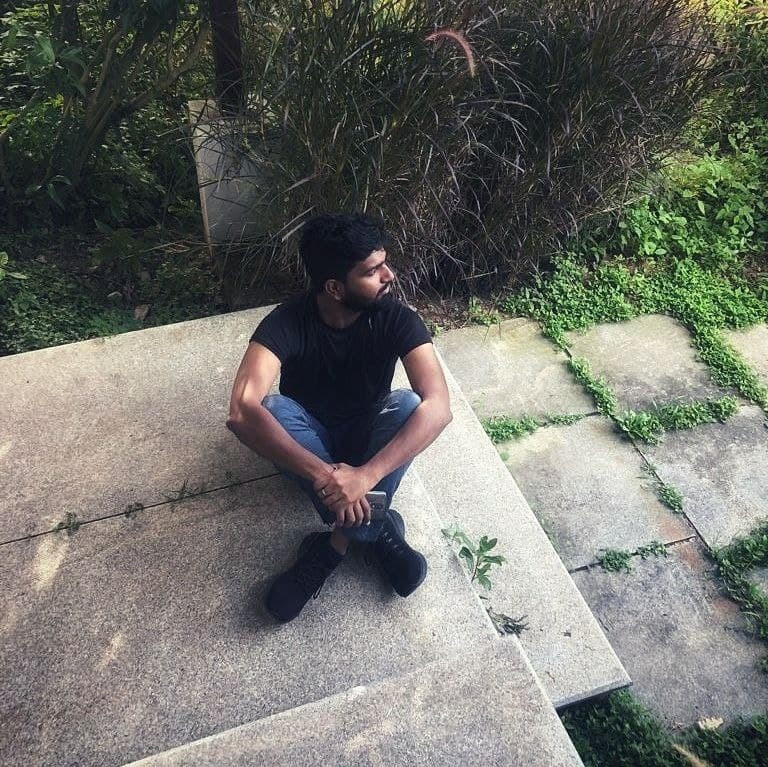Location
Contact
Things to do :
- Birding
- Guided Nature Walk
- Experiential Cooking Session
- Trek to Fatehgarh Fort
- Spa
- Yoga and Meditation
- Experiential Lunch / Dinner
- Regional Artist Performances
- Spice Mixing Session
- Walk with Villagers
As our car approaches the driveway of Brij Lakshman Sagar, in the Marwar region of Rajasthan, the vegetation shifts from intermittent rows of Prosopis juliflora to a more diverse affair. Thick tangles of thhor, numerous species of acacia, and prickly pear cacti crowd the slight hill that rises to the left. At the gate, we are greeted by the warm smile of an elderly gentleman wearing a blood-red pagri (turban) and a white angrakha (an outer robe with long sleeves), the traditional outfit of the Raika community. Deeparam, who is a potter by trade, also doubles as the hotel gatekeeper. A short climb from the parking reveals an almost lush valley with a large waterbody, like an oasis in the desert. However, your attention immediately turns to the two havelis straddling your vision, exuding an aura from a distant place and time in history.
A former hunting lodge, Lakshman Sagar was built in 1858 by Lakshman Singh Ji of the House of Raipur to host British emissaries and other noble families. The then Thakur of Raipur initially commissioned a large, manmade lake to attract game, later building machans (a raised platform) for tiger spotting and separate quarters for the men (Mardana) and women (Zanana), which catered to the mandate of formal spaces for mehfils and baithaks. Once the domain of princes and princesses, the Zanana and Mardana are now treasured remnants of a bygone era that reveal the Rajputana customs of purdah (screening women from men or strangers) and the grand hunting holiday traditions of royal families during the Raj.
In keeping with the hospitality and traditions of the House of Raipur, Brij Hotels has reimagined Lakshman Sagar as a luxury getaway to explore the culture and biodiversity of the region while embracing the slow pace of life in rural Rajasthan. The two ancient havelis, today, serve as communal lounging and dining spaces for the guests at Brij Lakshman Sagar. Stepping into the Mardana, which wears its swanky blue and lime flourishes with pride, we are greeted by the resort manager, Dilip Singh, who quickly processes our documents and serves us a delicious amla-based welcome drink. Nothing like a refreshing cold drink to offset the intense heat of Rajasthan summers! But before our taste buds can register the tangy zing of the gooseberry, we are buffeted by powerful, sweeping winds that take us by surprise. ‘Hold onto your hats!’ exclaims Dilip, with a wide smile. Pointing to the tall, hefty dining chairs made from babool (Acacia nilotica) that populate the open platform of the Mardana, Dilip says, ‘There have been times when all of them have been swept out in one go!’ Over the next two days, we will learn to hold on to our napkins and empty tumblers while dining at the Mardana.
From the bank of the lake, the large waterbody is a sight to behold, glittering like liquid gold under the blinding sun, an invaluable resource for all of life in and around Lakshman Sagar. All of a sudden, a booming almost-cat-like call fills the air. And again, and then again! Peafowl! On the far bank, we could see a couple of males with their long trains fanned out, and the rest of the pride who had taken shelter under the trees. Sarthak Awhad, one of the naturalists at the property, informed us that there are more than 400 peafowls in the surrounding area.
Bright pink flyers that fall off the rafters of the Zanana flutter in the wind like a woman’s chunari (a thin shawl). Turning a blind eye to her charms, we follow Dilip as he guides us around the tall haveli. A square-shaped, single-room structure to the left, which used to be the toilet for the women’s quarters, still serves its purpose. A steep climb up brings into view a jaw-dropping swimming pool, which has been carved into the rock on which the Zanana stands ever-so-proud. Made by 36 craftsmen, who chipped away at the monolithic rock over six months, the shape and form of the pool were dictated by the fissures in the geological formation. The pool resembles a naturally formed waterhole where rainwater has collected over the monsoon. Though the water looked extremely inviting, we bid farewell. But only after making a silent promise to ourselves to jump in at the first chance. The walk was long and winding, up and down, before we reached our abode for the next two days.
Spread across 32 acres of tropical thorn forests, hugging the perimeter of the lake are six cottages on either side. Nestled into the natural topography of the land, each mud and stone cottage is similar yet unique in its own right. Under the guidance of sustainable design firm Kamath Design Studio, the cottages have been meticulously planned and conceptualised with a zero-kilometre design principle. All the building materials were sourced locally—slate for the foundation, sun-dried mud bricks for the walls, sandstone for door and window frames, keekar and eucalyptus logs for the beams, local Bidasar marble for the flooring, and kheemp for roof thatching.
Cut from the same cloth as the Zanana and Mardana, the 900sq.m. cottages offer luxurious lodgings, each with a private splash pool that overlooks the lake. The interior spaces flow into each other, from the lounge to the bedroom to the bathroom, generously lit by large and small glass windows and brightly decorated with local influences reflective of life in rural Rajasthan. The photographs above the bed give insight into the different material inspirations for the interior decorations—a dhol (double-sided barrel drum) converted into a coffee table, a jalebi patal (wok) as a keyholder, the sarkanda grass (Tripidium bengalense) used to make the blinds, the wind chime installation in the foyer made from lota (pots), belan (rolling pins) and mathini (butter churners).
Tired after an early morning flight and a fair bit of time on the road, we ordered lunch to the room and settled into the chairs on the lakefront. Having raided condiments from the room to munch on, the lemon-squeezed cornflakes proved to be the pick of the bunch. Out on the water, coots and moorhen frolicked closer to the shore, and further out were a few Spot-billed Ducks and some egrets. Closer scrutiny of the adjacent bank revealed the bright crown of a Red-naped Ibis and an Indian Flapshell Turtle basking in the sun. The electric-blue streak of a kingfisher turned our attention to a hunting party of a White-throated Kingfisher, a Black Drongo and a flock of babblers. We even saw Yellow-eyed Babblers scrambling in the thick undergrowth by the splash pool, though barely giving us a glimpse of their red eyerings.
Suddenly, it started to drizzle, forcing us back inside and leaving us very confused about the location of our whereabouts. The Delhi weather makes its way here occasionally, we learned from the staff delivering our lunch Mumbai dabbawala-style. The food served at Brij Lakshman Sagar mirrors what the local villagers cook and eat. Using fresh ingredients from the farm and within the property, the focus is to serve hyperlocal food, according to the season. From sangri (bean-like pods of Prosopis cineraria) and gund (berry of Cordia dichotoma) to the tender shoots of chickpea and khair ki patta (leaves of Acacia catechu), the kitchen staff forage every day and plan the menu accordingly. The zero-kilometre principle also extends to the day-to-day running of the hotel, ensuring that the producer-consumer distance is reduced as much as possible.
After a quick nap, we joined head naturalist Dayal Singh Rajawat for an evening at the backwaters of the Lakkhi Dam, a wetland 15km away. Under a bleeding orange sky, we saw flocks and flocks of birds as they flew in to roost for the night. White-browed wagtails ran about on the bank, parakeets made a fuss in the tall tree nearby, and swallows swooped and swayed in the sky above. Apart from the usual suspects like plovers, stilts, herons, lapwings and cormorants, we saw Comb Ducks, Common Teals, Gadwalls, Red-crested Pochards and Eurasian Spoonbills, to name a few. Dayal threw out a colourful spread on the bonnet of the jeep and served us hungry birders piping hot masala chai and some delectable jeera cookies. Back at Lakshman Sagar, we called it a day with a delightful dinner at the Mardana in the pleasant company of a husband-wife duo who sang Rajasthani folk songs and played the magical Sarangi (a traditional three-stringed instrument).
I woke up the next morning to the sound of movement on the roof. There was a sudden whooshing noise, and through the large window that looked out at the splash pool, I watched as a peacock gracefully glided down to a tall, naked tree stump by the lake. As their loud, echoing calls filled the air, more peafowl took off from the cottage roof, urging me to join the early bird cohort at the break of dawn! Breakfast at the Mardana was made special by the soulful music of flautist Ravinder, who rattled off old Bollywood songs one after the other. A visually impaired boy from the nearby village, Ravinder plays morning and evening for the guests at Lakshman Sagar, as part of their efforts to encourage and provide for local artisans in the region.
The turtle-shaped coasters below the empty tumblers of fresh guava juice reminded us to take it slow and relax. Sarthak joined us as we headed out for a lazy stroll, keen to explore parts of the property we had yet to cover. Adjacent to the Mardana, the kitchen terrace serves as the grounds for the spice mixing workshop, where you can try your hand at grinding spices and grains using ghatti and other traditional, hand-powered tools. A massive Banyan tree looms over the kitchen and its grounds. Believed to be at least three centuries old, it is big enough to house both the havelis under its canopy. Next to its trunk, a raised rock that resembles a tombstone pays homage to a python that was put to death by a villager back in the day. Families who have called this land home for decades, still come to pray and repent for the actions of their ancestors.
We learnt from Sarthak that more than 5000 native plants were planted on the property during the renovation. Today, it boasts 130+ species of flora, including endemic species such as guggal (Commiphora wightii), one of the most valuable plants found in the Thar Desert. The overexploited plant species has since been declared critically endangered by the IUCN. It is almost surreal to explore and interact with the sheer diversity of this landscape, which seems so bereft of life at first glance. Lakshman Sagar and its surroundings are also home to 150+ species of resident and migratory birds. Nilgai, Golden Jackal, civets, hedgehogs, porcupines and hares have been recorded from within the property.
Late in the afternoon, while my colleague set out towards the Mardana to try her hand at pottery under the tutelage of Deeparam, I headed to the pool. The water had warmed up just enough through the day, perfect for a lazy swim! The birds were still lost in their afternoon siesta, lending a strange quietness to the surroundings. On the far bank of the lake, a large male Nilgai nervously lapped water into his parched throat. After a few laps, the bed by the pool provided a quiet moment to recharge and rejuvenate. As the sun climbed down lower, the Zanana cast its tall shadow over me, gently beckoning me to scale her heights and watch this gorgeous landscape swoon under the setting sun. I didn’t think twice!
The Zanana, dubbed the 'Barbie House' by many a tourist, owing to its bright pink adornments, is a curious design that propels its guests to keep climbing. The first floor is the widest part of the structure, with a central space decorated by a fountain, and a table and chair in the inner alcove. With bangles that cover the legs of the table from top to bottom and pink tie-up blouses on the back of the chairs, they are made to resemble the attire of a Raika woman. The second floor has a large balcony that looks out at the pool, and further up is a smaller terrace, open to the sky, perfect for a sundowner.
We spent the rest of the evening on the second-floor balcony, nibbling on pakora and sipping hot chai, as Ravinder worked his magic, the calm humming notes of his flute travelling across to us from the Mardana. We watched parakeets trace their paths in the sky, heading home in large flocks. Down below, on the ground, peafowls were on the way back to their roosting site. Row after row, they would take the exact same path, flying in from all around the property, landing in front of the Zanana, where they would cut across the pool to the rocks at the edge of the boundary wall. Every now and then, one of them would pause by the pool. Blissfully unaware of our presence, they would stand there and drink their heart’s fill before dragging their large trains back home.
Though I’m not completely aware of what the Zanana and Mardana offered its royalty in the days of yore, almost three centuries later, Brij Lakshman Sagar lends its guests a gateway into a world that seems to have largely stood still since the days of the Raj.



























